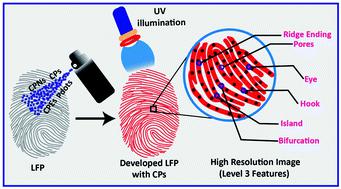当前位置:
X-MOL 学术
›
New J. Chem.
›
论文详情
Our official English website, www.x-mol.net, welcomes your feedback! (Note: you will need to create a separate account there.)
Advances in conjugated polymers for visualization of latent fingerprints: a critical perspective
New Journal of Chemistry ( IF 3.3 ) Pub Date : 2020-09-28 , DOI: 10.1039/d0nj04131a Akhtar Hussain Malik 1, 2, 3, 4, 5 , Nehal Zehra 4, 5, 6, 7 , Muzaffer Ahmad 4, 5, 6, 7 , Retwik Parui 4, 5, 6, 7 , Parameswar Krishnan Iyer 4, 5, 6, 7, 8
New Journal of Chemistry ( IF 3.3 ) Pub Date : 2020-09-28 , DOI: 10.1039/d0nj04131a Akhtar Hussain Malik 1, 2, 3, 4, 5 , Nehal Zehra 4, 5, 6, 7 , Muzaffer Ahmad 4, 5, 6, 7 , Retwik Parui 4, 5, 6, 7 , Parameswar Krishnan Iyer 4, 5, 6, 7, 8
Affiliation

|
This article provides an elaborate discussion of reports involving the development of latent fingerprints (LFPs) over the past decades with specific emphasis on the contribution of conjugated polymers (CPs) in the field of forensic science. CPs have been explored in the field of interdisciplinary sciences due to their widespread applications in the fields of imaging, chemical and biological sensors, electronic device, cancer therapeutics, etc. Even in the field of forensic sciences, these CP materials are in a continuous race with the existing technology and newer materials for the detection of fingerprint marks on various surfaces thus assisting in the unravelling of the precise identification of an individual suspect in modern criminology. Due to their excellent photophysical and chemical properties such as low toxicity, ease of functionalization, strong fluorescence emission, high quantum yield, and good optical stability, these CPs can lead to high resolution, and increased sensitivity and selectivity in the imaging of LFPs compared to those developed by traditional tedious methods. In this perspective, the challenges faced for LFP development and the role of various CPs including conjugated polyelectrolytes, polymer dots, and polymer nanoparticles are elaborately explained, thus, providing a systematic overview on techniques based on CPs as contrasting agents in the development of LFPs on various porous and nonporous substrates. There are various challenges pertaining to the development of LFPs on a multitude of surfaces which can be addressed by exploring materials with a suitable hydrophobic–hydrophilic balance and a receptor site for specific interactions with fingerprint components. The incorporation of this design principle has successfully led to the development of efficient platforms for rapid, onsite, intricate and unique LFP patterns on every kind of surface.
中文翻译:

潜在指纹可视化的共轭聚合物的进展:关键观点
本文对过去几十年来潜在指纹(LFP)的开发进行了详尽的讨论,重点是对共轭聚合物(CP)在法医学领域的贡献。由于CP在成像,化学和生物传感器,电子设备,癌症治疗等领域的广泛应用,因此在跨学科科学领域进行了探索。即使在法医科学领域,这些CP材料也与现有技术和用于检测各种表面上的指纹标记的较新材料处于不断的竞争中,从而有助于阐明现代犯罪学中对单个犯罪嫌疑人的精确身份。由于它们具有出色的光物理和化学特性,例如低毒性,易于功能化,强荧光发射,高量子产率和良好的光学稳定性,与LFP相比,这些CP可以产生高分辨率,并提高LFP成像的灵敏度和选择性。用传统的乏味方法开发的那些。从这个角度出发,详细解释了LFP开发面临的挑战以及各种CP的作用,包括共轭聚电解质,聚合物点和聚合物纳米颗粒,因此,提供了在各种多孔和无孔基材上开发LFP的过程中,基于CPs作为对比剂的技术的系统概述。在多种表面上开发LFP面临着各种挑战,可以通过探索具有合适的疏水-亲水平衡以及与指纹成分进行特定相互作用的受体位点的材料来解决。这种设计原理的结合成功地导致了高效平台的开发,该平台可在各种表面上快速,现场,复杂且独特地进行LFP图案加工。在多种表面上开发LFP面临着各种挑战,可以通过探索具有合适的疏水-亲水平衡以及与指纹成分进行特定相互作用的受体位点的材料来解决。这种设计原理的结合成功地导致了高效平台的开发,该平台可在各种表面上快速,现场,复杂且独特地进行LFP图案加工。在多种表面上开发LFP面临着各种挑战,可以通过探索具有合适的疏水-亲水平衡以及与指纹成分进行特定相互作用的受体位点的材料来解决。这种设计原理的结合成功地导致了高效平台的开发,该平台可在各种表面上快速,现场,复杂且独特地进行LFP图案加工。
更新日期:2020-11-03
中文翻译:

潜在指纹可视化的共轭聚合物的进展:关键观点
本文对过去几十年来潜在指纹(LFP)的开发进行了详尽的讨论,重点是对共轭聚合物(CP)在法医学领域的贡献。由于CP在成像,化学和生物传感器,电子设备,癌症治疗等领域的广泛应用,因此在跨学科科学领域进行了探索。即使在法医科学领域,这些CP材料也与现有技术和用于检测各种表面上的指纹标记的较新材料处于不断的竞争中,从而有助于阐明现代犯罪学中对单个犯罪嫌疑人的精确身份。由于它们具有出色的光物理和化学特性,例如低毒性,易于功能化,强荧光发射,高量子产率和良好的光学稳定性,与LFP相比,这些CP可以产生高分辨率,并提高LFP成像的灵敏度和选择性。用传统的乏味方法开发的那些。从这个角度出发,详细解释了LFP开发面临的挑战以及各种CP的作用,包括共轭聚电解质,聚合物点和聚合物纳米颗粒,因此,提供了在各种多孔和无孔基材上开发LFP的过程中,基于CPs作为对比剂的技术的系统概述。在多种表面上开发LFP面临着各种挑战,可以通过探索具有合适的疏水-亲水平衡以及与指纹成分进行特定相互作用的受体位点的材料来解决。这种设计原理的结合成功地导致了高效平台的开发,该平台可在各种表面上快速,现场,复杂且独特地进行LFP图案加工。在多种表面上开发LFP面临着各种挑战,可以通过探索具有合适的疏水-亲水平衡以及与指纹成分进行特定相互作用的受体位点的材料来解决。这种设计原理的结合成功地导致了高效平台的开发,该平台可在各种表面上快速,现场,复杂且独特地进行LFP图案加工。在多种表面上开发LFP面临着各种挑战,可以通过探索具有合适的疏水-亲水平衡以及与指纹成分进行特定相互作用的受体位点的材料来解决。这种设计原理的结合成功地导致了高效平台的开发,该平台可在各种表面上快速,现场,复杂且独特地进行LFP图案加工。



























 京公网安备 11010802027423号
京公网安备 11010802027423号